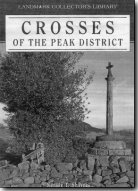Review of ‘Crosses of the Peak District’, by Neville T. SharpeThis review is by Julie Bunting, and was published originally in The Peak Advertiser, the Peak District's local free newspaper, on 20th May 2002, and is reproduced with Julie's kind permission.
We might think we know why stone crosses were erected, even roughly when, but things are not always as they seem. Certain crosses in churchyards turn out to be market or boundary crosses moved there for safekeeping, while some boundary crosses had a strong religious connection. Neville Sharpe's research confirms the existence of crosses leading in a straight line to a church, yet he questions the old supposition that certain crosses marked the boundaries of monastic land. He is adept at considering all the evidence surrounding his crosses - backed by a strong sense of intuition - and presenting tight conclusions. If he is unsure he says so, for instance of Beeley Moor cross in Bakewell churchyard he gives two accounts with the proviso ... 'Either or neither of these explanations might be true'. Of a broken cross on a stretch of heather moorland, he ponders whether it was broken by a landowner as part of a process of closing an old right of way. Sadly this is not an uncommon cause behind the disappearance of ancient crosses. On the bright side, the author has been ferreting with some success in stone walls and along grass verges, sometimes finding cross fragments serving second use as walling stone. And many a set of stone steps in churchyards are shown to be far older than the sundials and pillars which they support. Perhaps Neville Sharpe's best bit of detective work is a story of persistence paying off. After two and a half years of determined searching, he has unravelled a mass of misleading information to reach a conclusion about the famous Bow Stones. According to legend they were used by Robin Hood when stringing his famous bow but at last we have a sensible answer. We do well to note the words of this author: 'These examples of early Christian art should be as important to us as the Elgin Marbles are to the Greeks. As such, greater care should be taken with their preservation ...' Review by Julie Bunting |
|||
